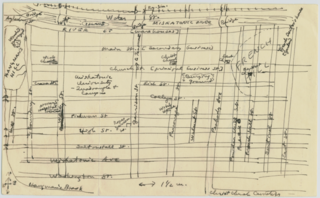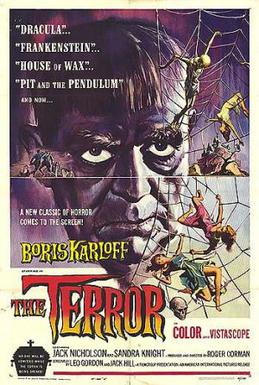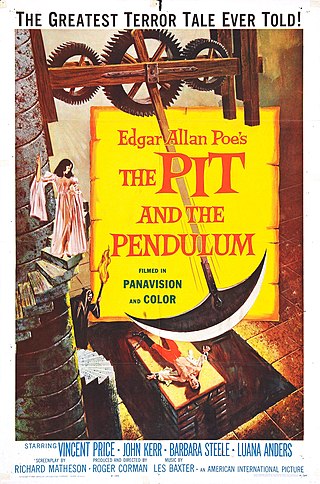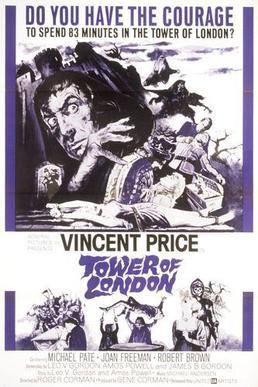
Arkham is a fictional city situated in Massachusetts, United States. An integral part of the Lovecraft Country setting created by H. P. Lovecraft, Arkham is featured in many of his stories and those of other Cthulhu Mythos writers.
American International Pictures LLC is an American film production company owned by Amazon MGM Studios. In its original operating period, AIP was an independent film production and distribution company known for producing and releasing films from 1955 until 1980, a year after its acquisition by Filmways in 1979.

The Raven is a 1963 American comedy gothic horror film produced and directed by Roger Corman. The film stars Vincent Price, Peter Lorre, and Boris Karloff as a trio of rival sorcerers. The supporting cast includes Jack Nicholson as the son of Lorre's character.

The Case of Charles Dexter Ward is a short horror novel by American writer H. P. Lovecraft, written in early 1927, but not published during the author's lifetime. Set in Lovecraft's hometown of Providence, Rhode Island, it was first published in the May and July issues of Weird Tales in 1941; the first complete publication was in Arkham House's Beyond the Wall of Sleep collection (1943). It is included in the Library of America volume of Lovecraft's work.

The Tomb of Ligeia is a 1964 British horror film directed by Roger Corman. Starring Vincent Price and Elizabeth Shepherd, it tells of a man haunted by the spirit of his dead wife and her effect on his second marriage. The screenplay by Robert Towne was based upon the short story "Ligeia" by American author Edgar Allan Poe and was the last in his series of films loosely based on the works of Poe. Tomb of Ligeia was filmed at Castle Acre Priory and other locations with a mostly British cast.

The Terror is a 1963 American independent horror film produced and directed by Roger Corman. The film stars Boris Karloff and Jack Nicholson, the latter of whom portrays a French officer who is seduced by a woman who is also a shapeshifting devil.

The Masque of the Red Death is a 1964 horror film directed by Roger Corman and starring Vincent Price. The story follows a prince who terrorizes a plague-ridden peasantry while merrymaking in a lonely castle with his jaded courtiers. The screenplay, written by Charles Beaumont and R. Wright Campbell, was based upon the 1842 short story of the same name by American author Edgar Allan Poe, and incorporates a subplot based on another Poe tale, "Hop-Frog". Another subplot is drawn from Torture by Hope by Auguste Villiers de l'Isle-Adam.

Elvira's Haunted Hills is a 2001 American comedy horror film directed by Sam Irvin and written by Cassandra Peterson and John Paragon. It is the second film starring Peterson in the title role, after the 1988 theatrical release Elvira: Mistress of the Dark. The film also stars Richard O'Brien and Mary Scheer.

House of Usher is a 1960 American gothic horror film directed by Roger Corman and written by Richard Matheson from the 1839 short story "The Fall of the House of Usher" by Edgar Allan Poe. The film was the first of eight Corman/Poe feature films and stars Vincent Price, Myrna Fahey, Mark Damon and Harry Ellerbe.

The Pit and the Pendulum is a 1961 horror film directed by Roger Corman, starring Vincent Price, Barbara Steele, John Kerr, and Luana Anders. The screenplay by Richard Matheson was loosely inspired by Edgar Allan Poe's 1842 short story of the same name. Set in sixteenth-century Spain, the story is about a young Englishman who visits a forbidding castle to investigate his sister's mysterious death. After a series of horrific revelations, apparently ghostly appearances and violent deaths, the young man becomes strapped to the titular torture device by his lunatic brother-in-law during the film's climactic sequence.
Daniel Haller is an American film and television director, production designer, and art director.
Dr. Terror's Gallery of Horrors is a low-budget 1967 colour scope anthology film by David L. Hewitt from stories by Russ Jones. The film includes footage from Roger Corman's Edgar Allan Poe adaptations. The similarity of its title to Amicus Productions' hit Dr. Terror's House of Horrors led to numerous enforced title changes, including Return from the Past, The Blood Suckers, Alien Massacre, and most commonly Gallery of Horror (on-screen) and Gallery of Horrors. It has also been released as The Witch's Clock, after the first story, and the only one to feature star John Carradine, who hosts the interstitial segments. It also stars Lon Chaney Jr., Rochelle Hudson, Roger Gentry and Vic McGee. The other stories include "King Vampire," "Monster Raid," "Spark of Life," and "Count Alucard," which is credited as "Count Dracula." In the latter story, Jonathan Harker is revealed, in a humorous twist, to be a werewolf.

American poet and short story writer Edgar Allan Poe has had significant influence in television and film. Many are adaptations of Poe's work, others merely reference it.
"The Haunted Palace" is a poem by Edgar Allan Poe. The 48-line poem was first released in the April 1839 issue of Nathan Brooks' American Museum magazine. It was eventually incorporated into "The Fall of the House of Usher" as a song written by Roderick Usher.
The horror-of-the-demonic film is one of three subgenres of the horror film that grew out of mid- and late-20th-century American culture.

Tower of London is a 1962 historical drama and gothic horror film directed by Roger Corman and starring Vincent Price and Michael Pate. The film was produced by Edward Small Productions.

Die, Monster, Die! is a 1965 science fiction horror film directed by Daniel Haller, and starring Boris Karloff, Nick Adams, Freda Jackson and Suzan Farmer. A loose adaptation of H. P. Lovecraft's story "The Colour Out of Space", its plot follows an American man who, while visiting his English fiancee's familial estate, uncovers a series of bizarre occurrences.
David Del Valle is a journalist, columnist, film historian, and radio and television commentator on horror, science-fiction, cult and fantasy films. Described by Entertainment Weekly as "Something of a cult celebrity himself," he was inducted into the Rondo Hatton Classic Horror Awards' Monster Kid Hall of Fame in 2016.

Masque of the Red Death is a 1989 American horror film produced by Roger Corman, and directed by Larry Brand, starring Adrian Paul and Patrick Macnee. The film is a remake of the 1964 picture of the same name which was directed by Roger Corman. The screenplay, written by Daryl Haney and Larry Brand, is based upon the classic 1842 short story of the same name by American author Edgar Allan Poe, concerning the exploits of Prince Prospero, who organizes a bal masqué in his castle while the peasants of his fiefdom die from the plague in great numbers.













